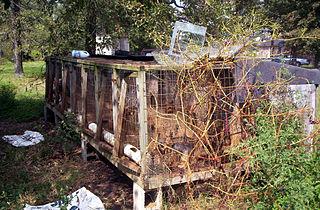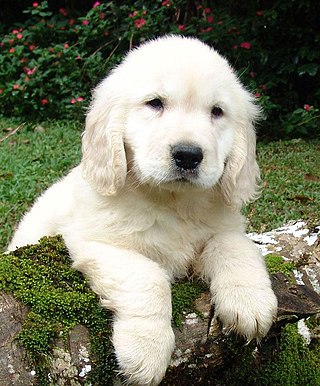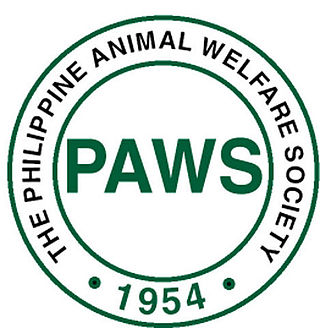Cultural behavior is behavior exhibited by humans that is extrasomatic or extragenetic—in other words, learned.

A puppy mill, also known as a puppy farm, is a commercial dog breeding facility characterized by quick breeding and poor conditions. Although no standardized legal definition for "puppy mill" exists, a definition was established in Avenson v. Zegart in 1984 as "a dog breeding operation in which the health of the mill’s dogs are disregarded to maintain a low overhead and maximize profits". They are cited as being a result of increased demand for household pets, especially after WWII. The Veterinary Medical Association of the Humane Society of the United States defines the main characteristics of a puppy mill as "emphasis on quantity over quality, indiscriminate breeding, continuous confinement, lack of human contact and environmental enrichment, poor husbandry, and minimal to no veterinary care."

Weaning is the process of gradually introducing an infant human or another mammal to what will be its adult diet while withdrawing the supply of its mother's milk.

Social grooming is a behavior in which social animals, including humans, clean or maintain one another's body or appearance. A related term, allogrooming, indicates social grooming between members of the same species. Grooming is a major social activity, and a means by which animals who live in close proximity may bond and reinforce social structures, family links, and build companionships. Social grooming is also used as a means of conflict resolution, maternal behavior and reconciliation in some species. Mutual grooming typically describes the act of grooming between two individuals, often as a part of social grooming, pair bonding, or a precoital activity.

Animal roleplay is a form of roleplay where at least one participant plays the part of a non-human animal. As with most forms of roleplay, its uses include play and psychodrama.

Anthrozoology, also known as human–nonhuman-animal studies (HAS), is the subset of ethnobiology that deals with interactions between humans and other animals. It is an interdisciplinary field that overlaps with other disciplines including anthropology, ethnology, medicine, psychology, social work, veterinary medicine, and zoology. A major focus of anthrozoologic research is the quantifying of the positive effects of human–animal relationships on either party and the study of their interactions. It includes scholars from fields such as anthropology, sociology, biology, history and philosophy.
Human bonding is the process of development of a close interpersonal relationship between two or more people. It most commonly takes place between family members or friends, but can also develop among groups, such as sporting teams and whenever people spend time together. Bonding is a mutual, interactive process, and is different from simple liking. It is the process of nurturing social connection.

In biology, a pair bond is the strong affinity that develops in some species between a mating pair, often leading to the production and rearing of offspring and potentially a lifelong bond. Pair-bonding is a term coined in the 1940s that is frequently used in sociobiology and evolutionary biology circles. The term often implies either a lifelong socially monogamous relationship or a stage of mating interaction in socially monogamous species. It is sometimes used in reference to human relationships.
Evolutionary musicology is a subfield of biomusicology that grounds the cognitive mechanisms of music appreciation and music creation in evolutionary theory. It covers vocal communication in other animals, theories of the evolution of human music, and holocultural universals in musical ability and processing.

A puppy is a juvenile dog. Some puppies can weigh 1–1.5 kg (2.2–3.3 lb), while larger ones can weigh up to 7–11 kg (15–24 lb). All puppies display primary altriciality and healthy puppies grow quickly after birth. A puppy's coat color may change as the puppy grows older, as is commonly seen in breeds such as the Yorkshire Terrier. Puppy refers specifically to young dogs, while pup may be used for other animals such as wolves, seals, giraffes, guinea pigs, rats or sharks.
In psychology, an affectional bond is a type of attachment behavior one individual has for another individual, typically a caregiver for her or his child, in which the two partners tend to remain in proximity to one another. The term was coined and subsequently developed over the course of four decades, from the early 1940s to the late 1970s, by psychologist John Bowlby in his work on attachment theory. The core of the term affectional bond, according to Bowlby, is the attraction one individual has for another individual. The central features of the concept of affectional bonding can be traced to Bowlby's 1958 paper, "The Nature of the Child's Tie to his Mother".

Dog behavior is the internally coordinated responses of individuals or groups of domestic dogs to internal and external stimuli. It has been shaped by millennia of contact with humans and their lifestyles. As a result of this physical and social evolution, dogs have acquired the ability to understand and communicate with humans. Behavioral scientists have uncovered a wide range of social-cognitive abilities in domestic dogs.

The Philippine Animal Welfare Society (PAWS) is a volunteer-based, non-government organization whose goal is to prevent animal cruelty through education, animal sheltering and advocacy, based in Quezon City, Philippines. It was founded in 1954 by Muriel Jay. PAWS believes that the creation of a more peaceful society starts with the widening of mankind's circle of compassion which includes animals, thereby envisions a nation that respects animals, practices responsible pet ownership and protects wildlife. The volunteer-based organization rehabilitates these animals in the hope of finding them new homes and a second chance at a good life. PAWS does not take in pets of other people, but only victims of cruelty or neglect where the animal offenders are charged with violation of the Animal Welfare Act in court.
Socialization of animals is the process of training animals so that they can be kept in close relationship to humans.

Petland is a privately owned operator and franchisor of pet stores based in Chillicothe, Ohio. Ed Kunzelman founded the company in 1967. Petland currently operates 131 stores in the United States, and at least 63 in foreign markets including Canada, Japan, China, Mexico, Brazil and El Salvador. The chain is notable for its controversy over documentation from the Humane Society of the United States revealing the purchase of dogs from puppy mills.

Human–canine bonding is the relationship between dogs and humans. This relationship can be traced back to at least 15,000 years ago, to the Bonn-Oberkassel dog, who was found buried alongside two humans. For centuries, dogs have been considered man's best friend. This is most evident in western countries, such as the United States, where over 48% of households have a pet dog.

Cats and dogs have a range of interactions. The natural instincts of each species lead towards antagonistic interactions, though individual animals can have non-aggressive relationships with each other, particularly under conditions where humans have socialized non-aggressive behaviors.

Non-reproductive sexual behavior consists of sexual activities animals participate in that do not lead to the reproduction of the species. Although procreation continues to be the primary explanation for sexual behavior in animals, recent observations on animal behavior have given alternative reasons for the engagement in sexual activities by animals. Animals have been observed to engage in sex for social interaction bonding, exchange for significant materials, affection, mentorship pairings, sexual enjoyment, or as demonstration of social rank. Observed non-procreative sexual activities include non-copulatory mounting, oral sex, genital stimulation, anal stimulation, interspecies mating, and acts of affection, although it is doubted that they have done this since the beginning of their existence. There have also been observations of sex with cub participants, same-sex sexual interaction, as well as sex with dead animals.

An interspecies friendship is a nonsexual bond that is formed between animals of different species. Numerous cases of interspecies friendships among wild and domesticated animals have been reported and documented with photography and video. Domestication of animals has led to interspecies friendships between species that would never naturally exist together. In many cases of interspecies friendship, the species are not normally seen together, and sometimes, one is of a species that ordinarily preys on the other in nature.

A human–animal hybrid and animal–human hybrid is an organism that incorporates elements from both humans and non-human animals. Technically, in a human–animal hybrid, each cell has both human and non-human genetic material. It is in contrast to an individual where some cells are human and some are derived from a different organism, called a human-animal chimera.














